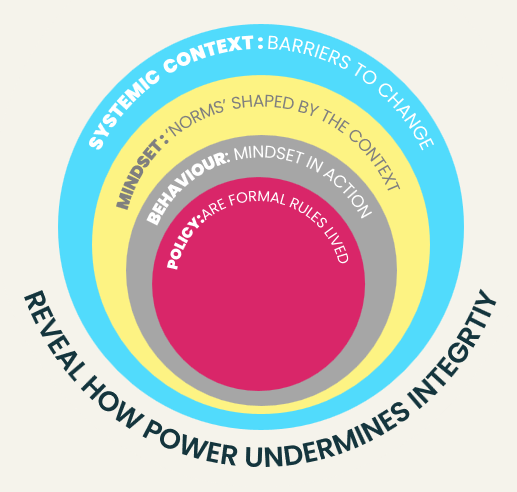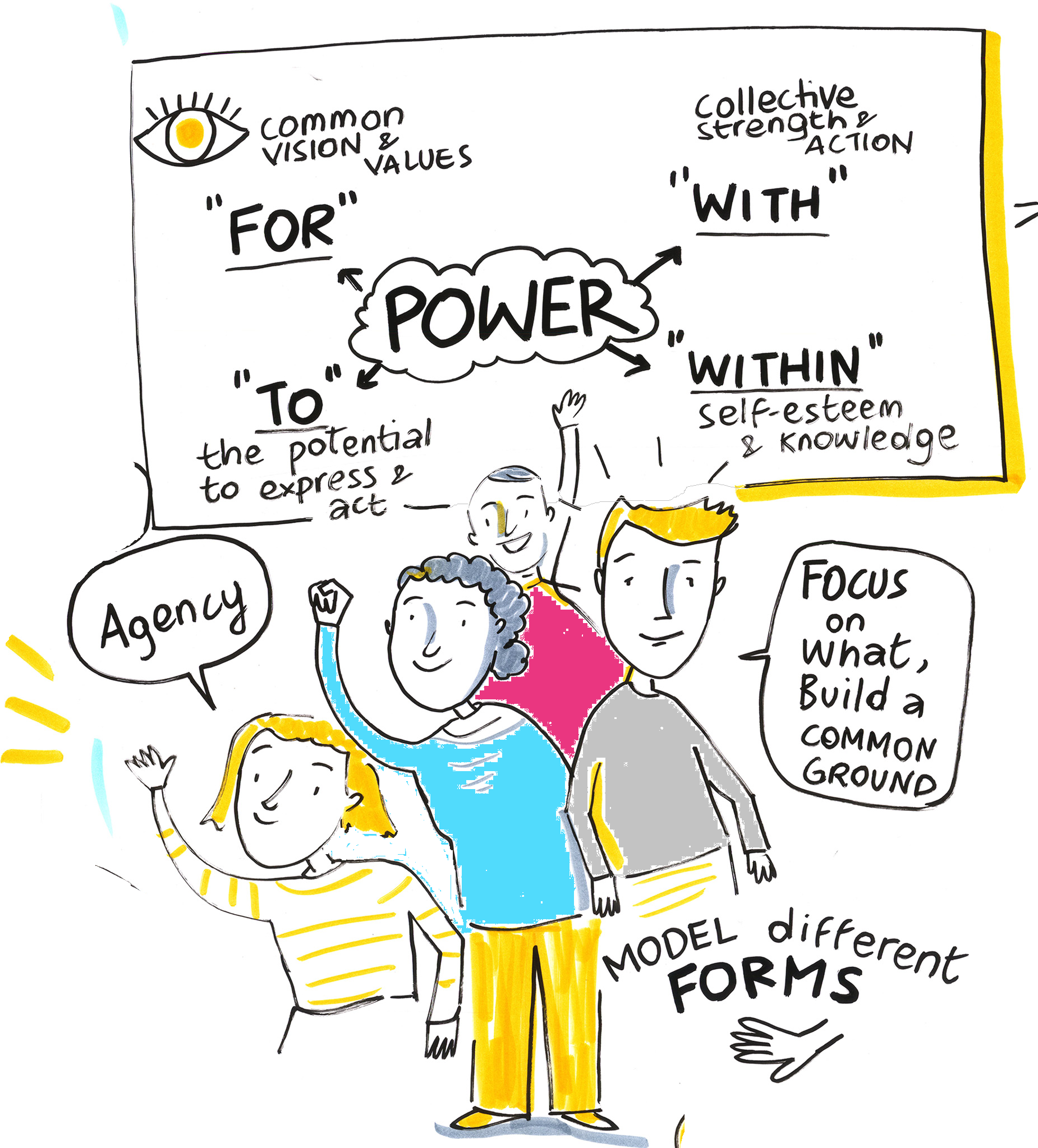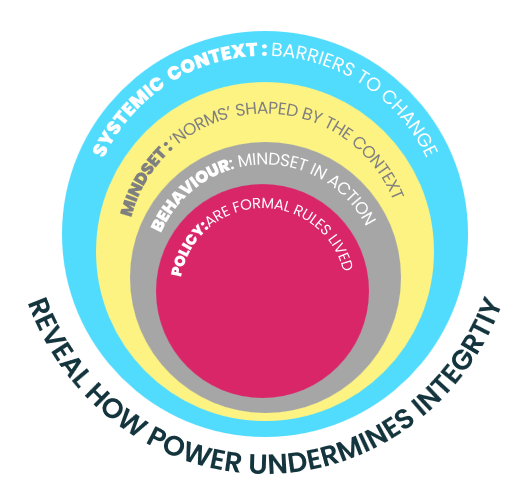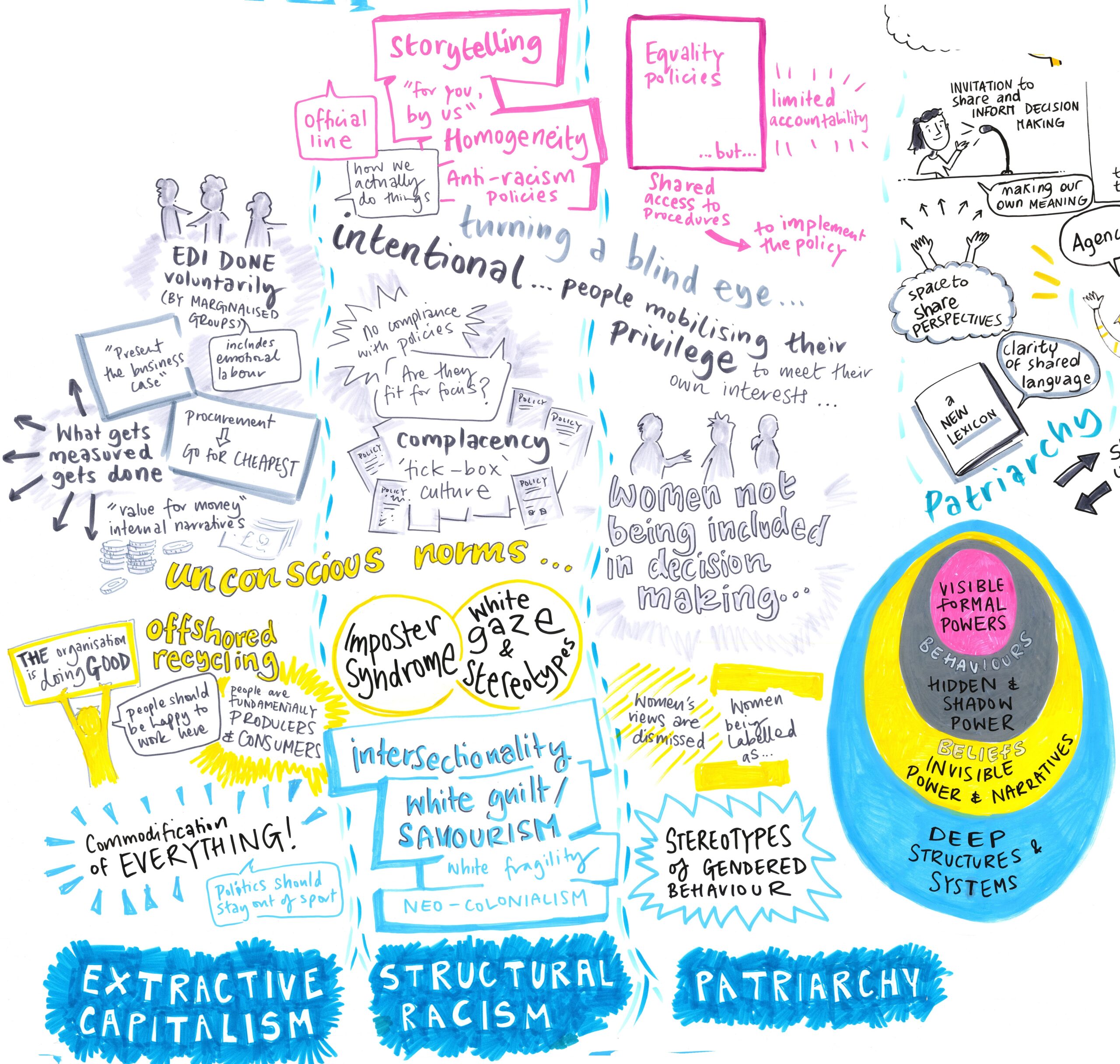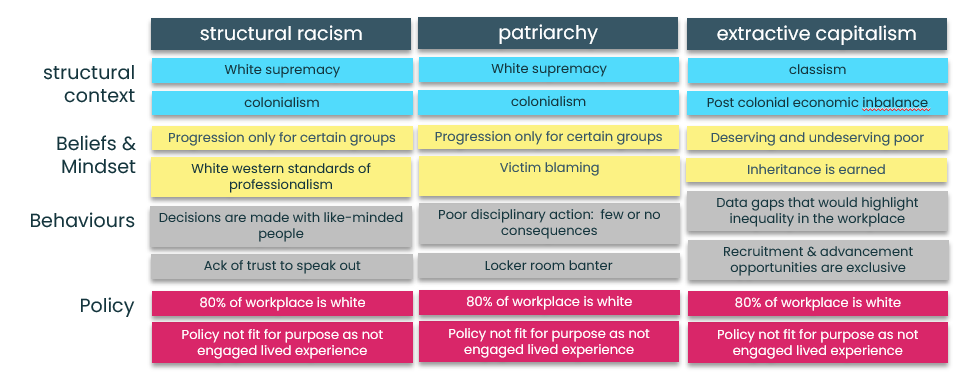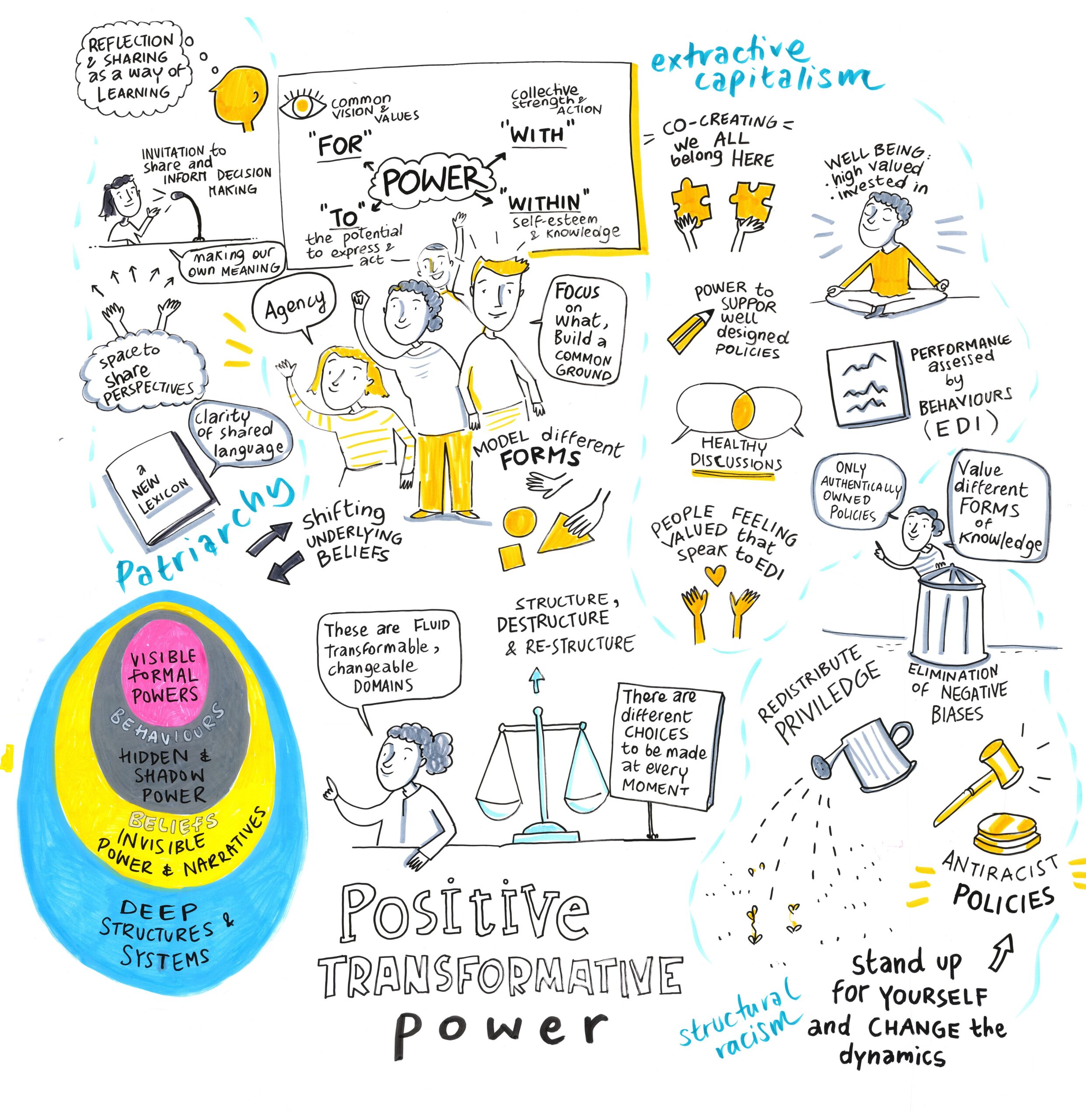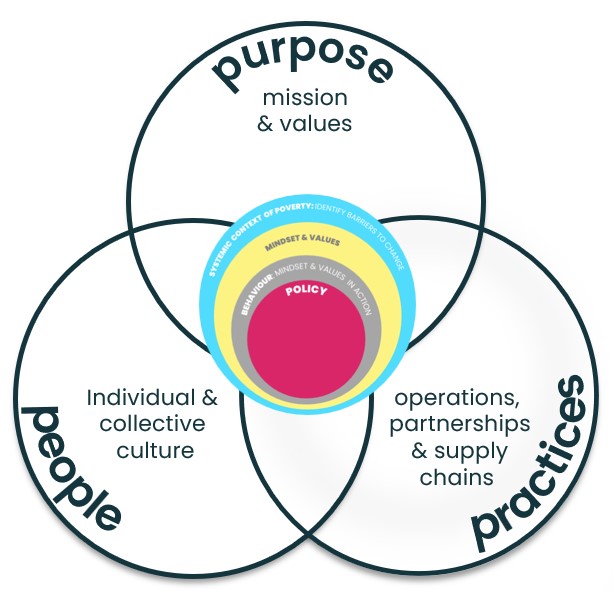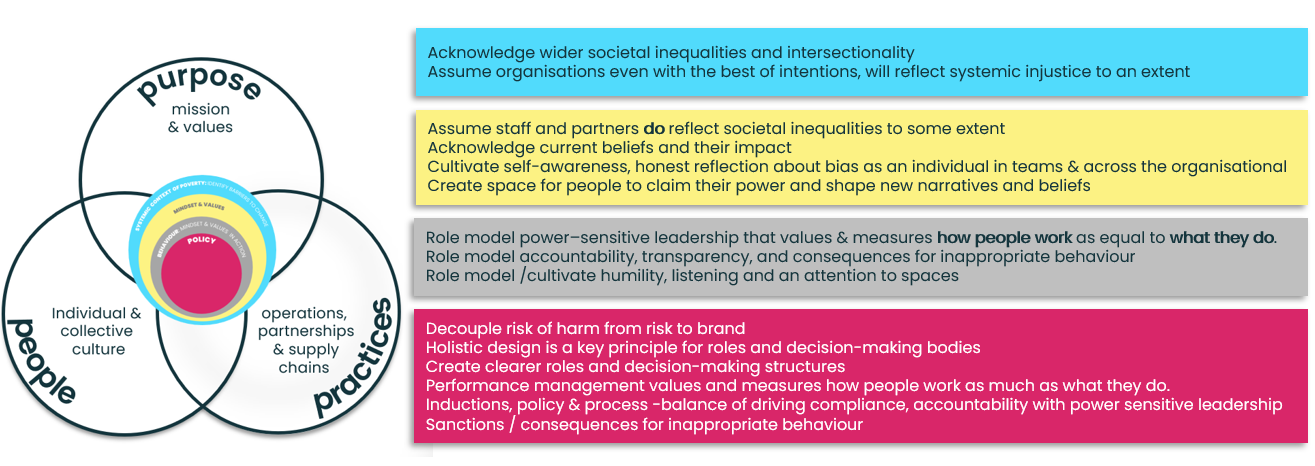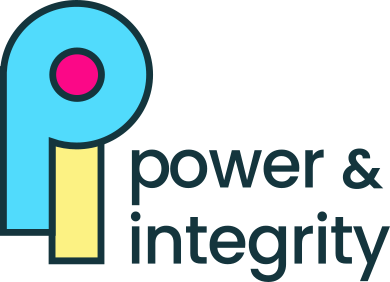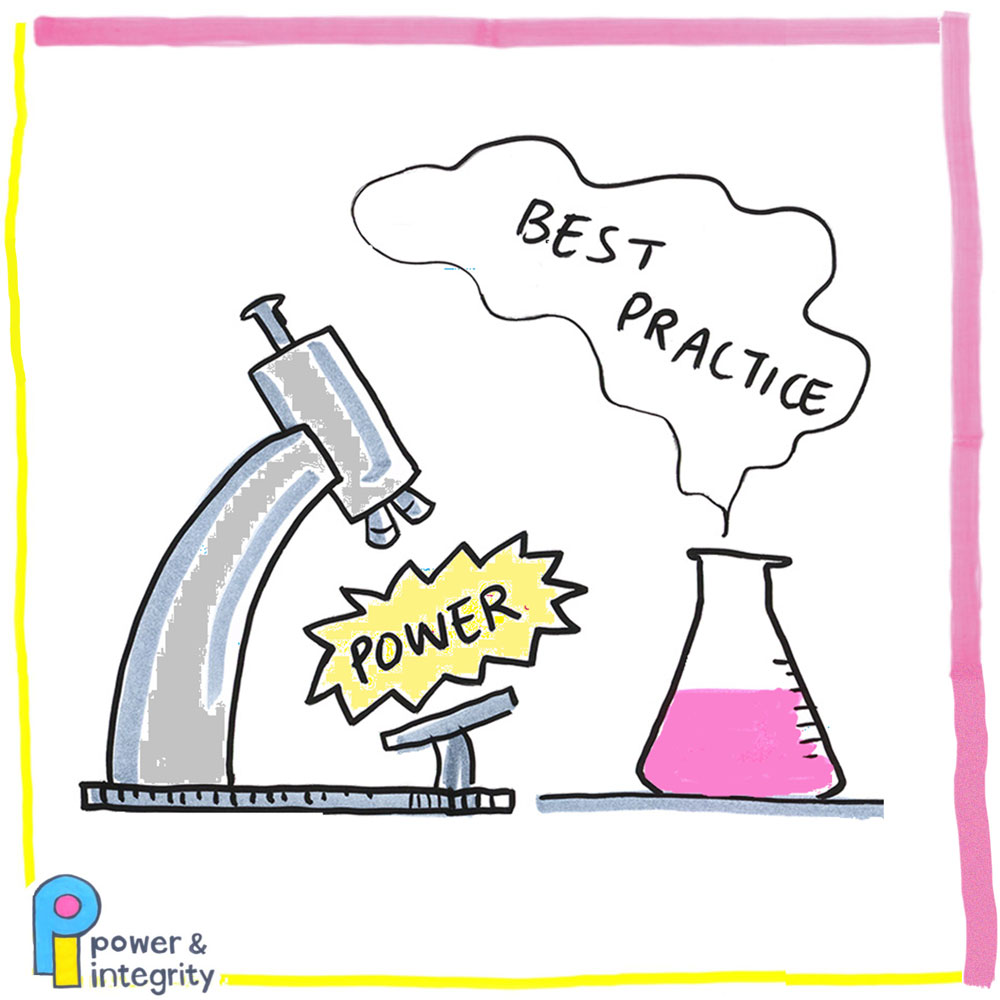
Power lab learning
2Power
We found that the power lens adapts well for organisations, and enables a coherent, holistic and intersectional approach to integrity. Learning about power is uncomfortable but essential.
Power and organisational integrity insights
Power lab 2
Aims and assumptions
PI’s main thesis is that understanding and addressing power is the key to organisational integrity. In Power Lab 2, we wanted to explore:
- How power plays out within organisations.
- If understanding power in an organisational context can help us identify what undermines or enhances integrity.
- If power analysis provides a lens through which we can see a holistic and intersectional view of organisational integrity.
What is ‘power’?
Power can be positive and liberating, but also negative and oppressive. It exists within and between people and groups, and at a wider societal level. Deeply embedded power structures shape our culture, ways of working, biases and social norms.
This understanding comes from power analysis, developed within civil society and academia to address inequality, citizen participation and environmental decline.
Tools and activities
Tools
Power Lens
We adapted the Four dimensions of power framework for an organisational context to:
- Investigate the root causes of how organisations can cause or perpetuate harm
- Highlight the experiences and consequences this harm can cause
- Understand how an organisation’s rules and structures can undermine integrity.
Transformative power framework
This tool helps us look at different forms of individual and collective power, and how they can be understood, created, and expressed as transformative – as an essential and positive force for change.
There are four main forms within the framework:
- power within: self-esteem and self-knowledge
- power with: collective strength and action
- power to: the potential to express oneself and act
- power for: a common vision, values and requirements
Activities
As with lab 1, activities in this lab, were participatory, but quite structured and propositional in terms of content, methods and shared language. We worked together to through activities to reveal how power manifests in organisations to undermine integrity, and we imagined how power could transform organisations to embody integrity.
understanding power
What we learned
1The power lens shows how power plays out in organisations
In the Reveal and Imagine activities, the power lens helped us draw a picture of how power manifests within organisations. Participants were able to examine the effects of power in the different lens dimensions, and how this interacted with other forms of power.
As well as successfully applying the lens across patriarchy, systemic racism and extractive capitalism, participants agreed the power lens could be:
- applied to other forms of structural power, such as ablism and classism
- adapted and expanded to include additional forms as they are recognised.
2 Organisations unintentionally perpetuate societal inequalities
The Reveal activity showed how deeply embedded systemic power structures can both influence beliefs and behaviours and feed into policy and practice. This root cause analysis enabled us to identify how formal policies and decision-making structures can perpetuate inequality by upholding negative norms and standards.
Before attempting to change working culture and practices, it’s necessary to:
- fully acknowledge systemic power
- understand how it manifests internally
- develop measures for representation within decision making structures.
Example of patriarchy and gender
Under patriarchy, women typically bear the brunt of caregiving, so often work part time. Men are usually deterred from part-time working; employers may consider them insufficiently serious about their work, so it risks their career progression. Part time work is therefore devalued.
Since progression for part-time women is challenging, it’s less likely they become decision makers. And with fewer women in decision-making roles, it’s more likely a gender equity policy is poorly informed about how ensure gender equality in the workplace. So it fails to do so.
3 Different forms of inequality shape similar mindsets and behaviours of exclusion
During the Reveal activity, we saw there were commonalities in behaviour, beliefs and policy across a range of systemic root causes. Without dismissing the distinct characteristics and experience of each form of exclusion, this helped us identify some of the shared root causes.
For example, beliefs about ability, commitment, or professionalism are often shaped by deeper societal bias against gender, race or economic status (and many other forms). These can all lead to being dismissive of a specific group’s views, reducing opportunities for promotion and decision making on strategy and policy.
4 Anti-oppression work must be intersectional
Discussions of oppression are often too simplistic. There’s a tendency to either attempt to determine which form of oppression is most significant or treat all forms equally.
The Reveal activity highlighted the need for more nuance. Viewing race, gender and class alongside each other, we could start to see how the systems intersect and experiences of oppression can compound each other
This intersectional mapping helps demonstrate that all forms of oppression are bound together, coexisting with varying levels of prominence within a single, interweaving system of oppression. Each individual person experiences a unique blend of oppression and privilege.
Understanding intersectionality is vital to the holistic design and shared accountability that are necessary for transformative change. To illustrate this, we placed the 3Ps Model within a circle of oppression.
5 Learning about power is uncomfortable but necessary
Both participants and the PI team expressed moments of discomfort during the lab. But we recognised this as an important part of the learning process. Leaning into it can broaden understanding and perspectives, while also challenging our own thinking.
Awareness of cognitive dissonance is vital to this process. Being able to actively listen to feedback and perspectives that are at odds with how we perceive ourselves is necessary for transformational change..
6 Power analysis helps identify foundational steps towards integrity
The Imagine activity helps organisations understand how they can enable positive transformational power coherently across a range of integrity issues and activities, and more widely across its people, purpose and practices.
Having formed a vison of the transformed organisation, the power lens helped us look at the steps needed to bring about this transformation. We found many of these steps were foundational to most, if not all the integrity issues. They provided a coherent base on which to add issue-specific knowledge and perspectives needed to address different forms of exclusion in an intersectional way.
Building on insights from the lab, the PI team has developed this list of example foundational steps towards integrity.
7 The power lens and 3Ps model combined enable a coherent and integrity-centred approach
Post lab comments & survey
Participant views
- Participants found the power lens helpful and gave an average rating of 3.4 out of 4.
- Overall, participants agreed that behaviour and beliefs were critical spaces to create change.
- After completing the power lens activities, there was a strong sense that we had reached a more tangible phase of our learning journey.
- Participants commented on an ‘aha!’ moment when power helped them understand integrity better. The 3Ps also felt more palpable.
- We need to be more explicit connection to systems of oppression and how policy legitimises beliefs
“The power lens helps to dissect the different aspects of where power lies.”
Beyond the Lab
Developing our learning
The PI team has been working with three organisations to put the tools into practice, develop case examples of the power lens and 3Ps Model applied. Watch this space for examples of practical application and further evolution of the tools.
Activity
Reveal how power undermines integrity
We created this activity to reveal how power can undermine integrity at work.
Three participant groups were each allocated a structural power of societal inequality – patriarchy, structural racism or extractive capitalism – to consider while working through questions relating to the four dimensions of the power lens.
Groups worked through the questions in order, from blue to pink, writing answers on post-it notes of the relevant colour.
We started with the systemic context to so that people think about root causes from the onset. This also helped depersonalise the exercise.
The reveal questions
Grouping the post-its on the wall provided a useful representation of how power is experienced within an organisation
Activity
Imagine how power can enable organisational integrity
This helped participants visualise what an organisation would look like transformed: living its aim of organisational integrity.
We discussed how power can transformed from negative to positive through policy, beliefs and behaviours. Since this transformed organisation would still operate within a wider context of structural inequality, we then applied the power lens. The three participant groups of patriarchy, extractive capitalism and structured racism discussed what beliefs and behaviours within a transformed organisation could look like. As with the Reveal activity, we grouped post-its with examples on the wall.
The activity then draws on the four dimensions of the transformative power framework – power within, power with, power to and power for – to imagine an organisation that embodies integrity by harnessing positive power.
Finally, we discussed together what was needed to facilitate change: how formal rules could help organisations realise this vision.
Activity
Foundational steps towards integrity
Building on insights from the lab, the PI team has developed this list of example steps
Find out more about the PI initiative
Check out our media channels
We’re starting to explain more about PI at events and via blogs and other media channels. See what’s available on our news page.
Stay updated
If you want to know how our work is progressing, why not join the PI mailing list? We’ll let you know about news, upcoming events and other important information.
Get in touch
Do you want to know more about participating in the PI initiative? Perhaps you have a media enquiry or just a general enquiry about our work? If so, let us know.

